HRD 10 Report: Analysis and Planning of Tesco PLC Employee Development
VerifiedAdded on 2020/04/29
|20
|5197
|150
Report
AI Summary
This report provides a comprehensive analysis of the Human Resource Development (HRD) practices within Tesco PLC. It begins with an introduction to HRD and its significance, followed by an examination of various learning styles suitable for Tesco employees, including visual, read-write, auditory, and kinesthetic approaches. The report then explores the role of the learning curve and knowledge transfer in the workplace, emphasizing their impact on employee skill development. It also discusses the importance of learning theories in designing effective training events. The second part of the report delves into the training needs of employees at different levels within Tesco, comparing various training methods, and outlining a systematic approach to planning a training event. This includes training needs analysis, setting objectives, and designing the training program. Finally, the report presents an evaluation form to assess the learning outcomes of the training program, analyzes the collected responses, and assesses the overall success of the evaluation form. The report concludes with a discussion on the future of skills and lifelong learning in the UK.
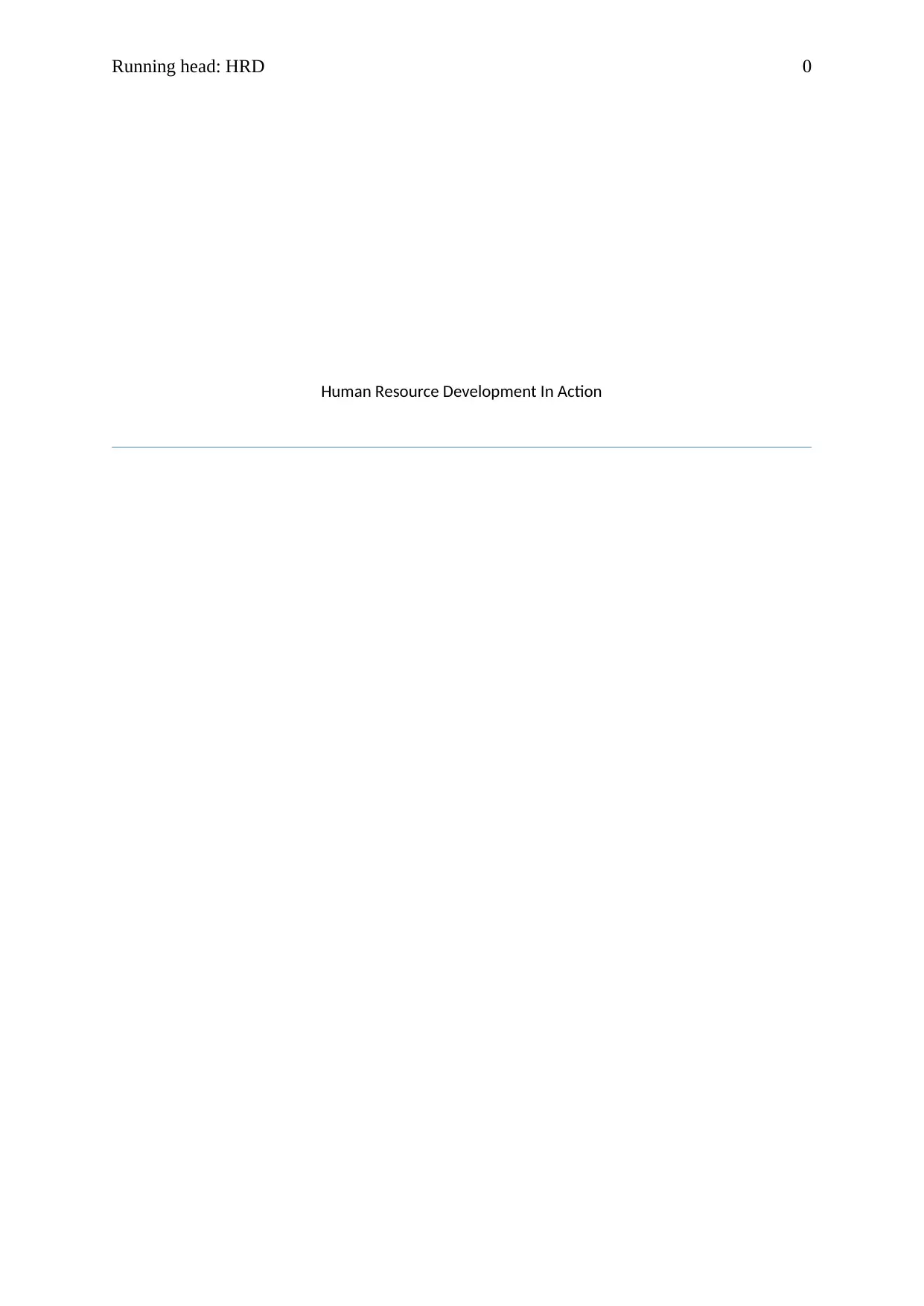
Running head: HRD 0
Human Resource Development In Action
Human Resource Development In Action
Paraphrase This Document
Need a fresh take? Get an instant paraphrase of this document with our AI Paraphraser
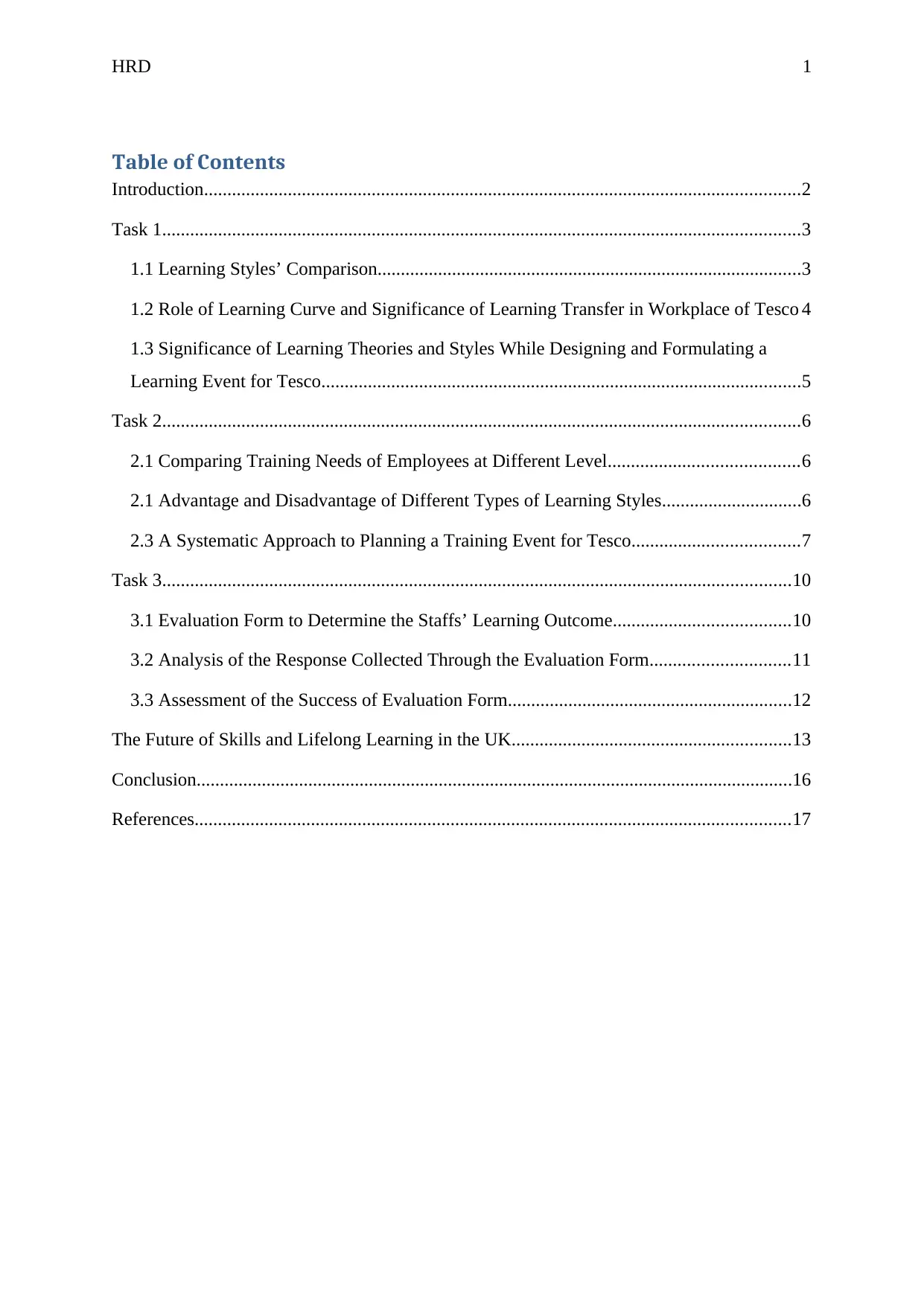
HRD 1
Table of Contents
Introduction................................................................................................................................2
Task 1.........................................................................................................................................3
1.1 Learning Styles’ Comparison...........................................................................................3
1.2 Role of Learning Curve and Significance of Learning Transfer in Workplace of Tesco 4
1.3 Significance of Learning Theories and Styles While Designing and Formulating a
Learning Event for Tesco.......................................................................................................5
Task 2.........................................................................................................................................6
2.1 Comparing Training Needs of Employees at Different Level.........................................6
2.1 Advantage and Disadvantage of Different Types of Learning Styles..............................6
2.3 A Systematic Approach to Planning a Training Event for Tesco....................................7
Task 3.......................................................................................................................................10
3.1 Evaluation Form to Determine the Staffs’ Learning Outcome......................................10
3.2 Analysis of the Response Collected Through the Evaluation Form..............................11
3.3 Assessment of the Success of Evaluation Form.............................................................12
The Future of Skills and Lifelong Learning in the UK............................................................13
Conclusion................................................................................................................................16
References................................................................................................................................17
Table of Contents
Introduction................................................................................................................................2
Task 1.........................................................................................................................................3
1.1 Learning Styles’ Comparison...........................................................................................3
1.2 Role of Learning Curve and Significance of Learning Transfer in Workplace of Tesco 4
1.3 Significance of Learning Theories and Styles While Designing and Formulating a
Learning Event for Tesco.......................................................................................................5
Task 2.........................................................................................................................................6
2.1 Comparing Training Needs of Employees at Different Level.........................................6
2.1 Advantage and Disadvantage of Different Types of Learning Styles..............................6
2.3 A Systematic Approach to Planning a Training Event for Tesco....................................7
Task 3.......................................................................................................................................10
3.1 Evaluation Form to Determine the Staffs’ Learning Outcome......................................10
3.2 Analysis of the Response Collected Through the Evaluation Form..............................11
3.3 Assessment of the Success of Evaluation Form.............................................................12
The Future of Skills and Lifelong Learning in the UK............................................................13
Conclusion................................................................................................................................16
References................................................................................................................................17
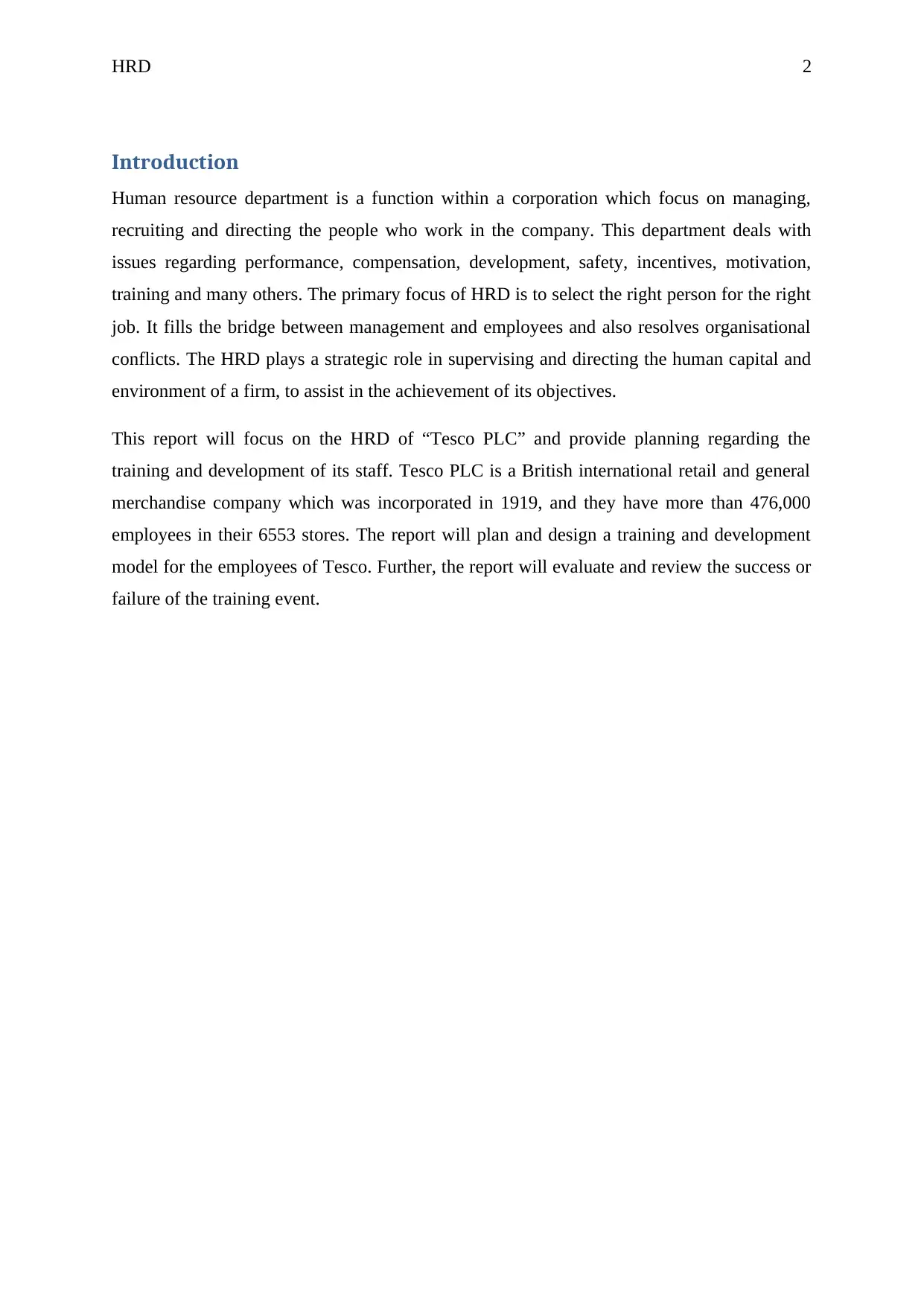
HRD 2
Introduction
Human resource department is a function within a corporation which focus on managing,
recruiting and directing the people who work in the company. This department deals with
issues regarding performance, compensation, development, safety, incentives, motivation,
training and many others. The primary focus of HRD is to select the right person for the right
job. It fills the bridge between management and employees and also resolves organisational
conflicts. The HRD plays a strategic role in supervising and directing the human capital and
environment of a firm, to assist in the achievement of its objectives.
This report will focus on the HRD of “Tesco PLC” and provide planning regarding the
training and development of its staff. Tesco PLC is a British international retail and general
merchandise company which was incorporated in 1919, and they have more than 476,000
employees in their 6553 stores. The report will plan and design a training and development
model for the employees of Tesco. Further, the report will evaluate and review the success or
failure of the training event.
Introduction
Human resource department is a function within a corporation which focus on managing,
recruiting and directing the people who work in the company. This department deals with
issues regarding performance, compensation, development, safety, incentives, motivation,
training and many others. The primary focus of HRD is to select the right person for the right
job. It fills the bridge between management and employees and also resolves organisational
conflicts. The HRD plays a strategic role in supervising and directing the human capital and
environment of a firm, to assist in the achievement of its objectives.
This report will focus on the HRD of “Tesco PLC” and provide planning regarding the
training and development of its staff. Tesco PLC is a British international retail and general
merchandise company which was incorporated in 1919, and they have more than 476,000
employees in their 6553 stores. The report will plan and design a training and development
model for the employees of Tesco. Further, the report will evaluate and review the success or
failure of the training event.
⊘ This is a preview!⊘
Do you want full access?
Subscribe today to unlock all pages.

Trusted by 1+ million students worldwide
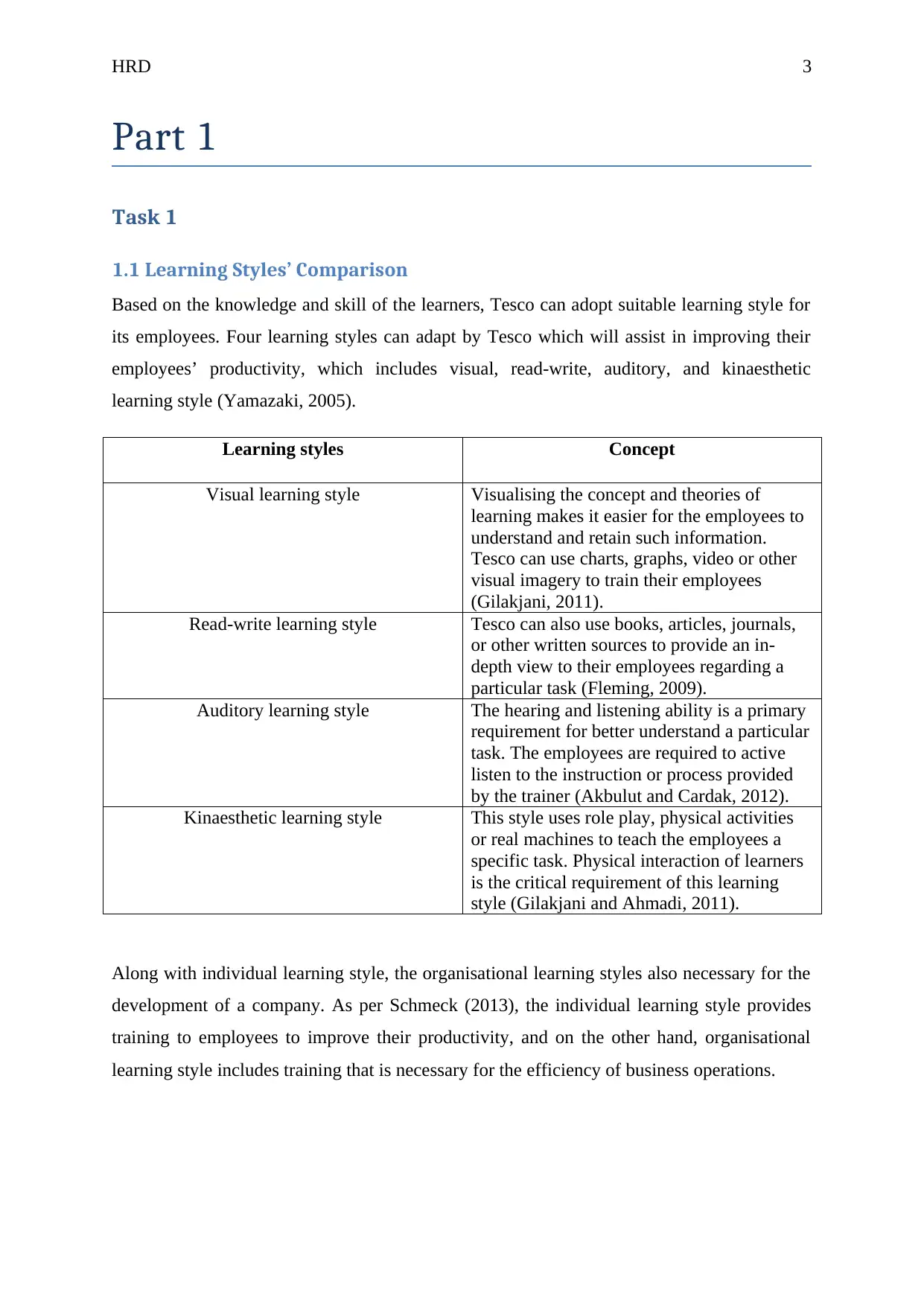
HRD 3
Part 1
Task 1
1.1 Learning Styles’ Comparison
Based on the knowledge and skill of the learners, Tesco can adopt suitable learning style for
its employees. Four learning styles can adapt by Tesco which will assist in improving their
employees’ productivity, which includes visual, read-write, auditory, and kinaesthetic
learning style (Yamazaki, 2005).
Learning styles Concept
Visual learning style Visualising the concept and theories of
learning makes it easier for the employees to
understand and retain such information.
Tesco can use charts, graphs, video or other
visual imagery to train their employees
(Gilakjani, 2011).
Read-write learning style Tesco can also use books, articles, journals,
or other written sources to provide an in-
depth view to their employees regarding a
particular task (Fleming, 2009).
Auditory learning style The hearing and listening ability is a primary
requirement for better understand a particular
task. The employees are required to active
listen to the instruction or process provided
by the trainer (Akbulut and Cardak, 2012).
Kinaesthetic learning style This style uses role play, physical activities
or real machines to teach the employees a
specific task. Physical interaction of learners
is the critical requirement of this learning
style (Gilakjani and Ahmadi, 2011).
Along with individual learning style, the organisational learning styles also necessary for the
development of a company. As per Schmeck (2013), the individual learning style provides
training to employees to improve their productivity, and on the other hand, organisational
learning style includes training that is necessary for the efficiency of business operations.
Part 1
Task 1
1.1 Learning Styles’ Comparison
Based on the knowledge and skill of the learners, Tesco can adopt suitable learning style for
its employees. Four learning styles can adapt by Tesco which will assist in improving their
employees’ productivity, which includes visual, read-write, auditory, and kinaesthetic
learning style (Yamazaki, 2005).
Learning styles Concept
Visual learning style Visualising the concept and theories of
learning makes it easier for the employees to
understand and retain such information.
Tesco can use charts, graphs, video or other
visual imagery to train their employees
(Gilakjani, 2011).
Read-write learning style Tesco can also use books, articles, journals,
or other written sources to provide an in-
depth view to their employees regarding a
particular task (Fleming, 2009).
Auditory learning style The hearing and listening ability is a primary
requirement for better understand a particular
task. The employees are required to active
listen to the instruction or process provided
by the trainer (Akbulut and Cardak, 2012).
Kinaesthetic learning style This style uses role play, physical activities
or real machines to teach the employees a
specific task. Physical interaction of learners
is the critical requirement of this learning
style (Gilakjani and Ahmadi, 2011).
Along with individual learning style, the organisational learning styles also necessary for the
development of a company. As per Schmeck (2013), the individual learning style provides
training to employees to improve their productivity, and on the other hand, organisational
learning style includes training that is necessary for the efficiency of business operations.
Paraphrase This Document
Need a fresh take? Get an instant paraphrase of this document with our AI Paraphraser
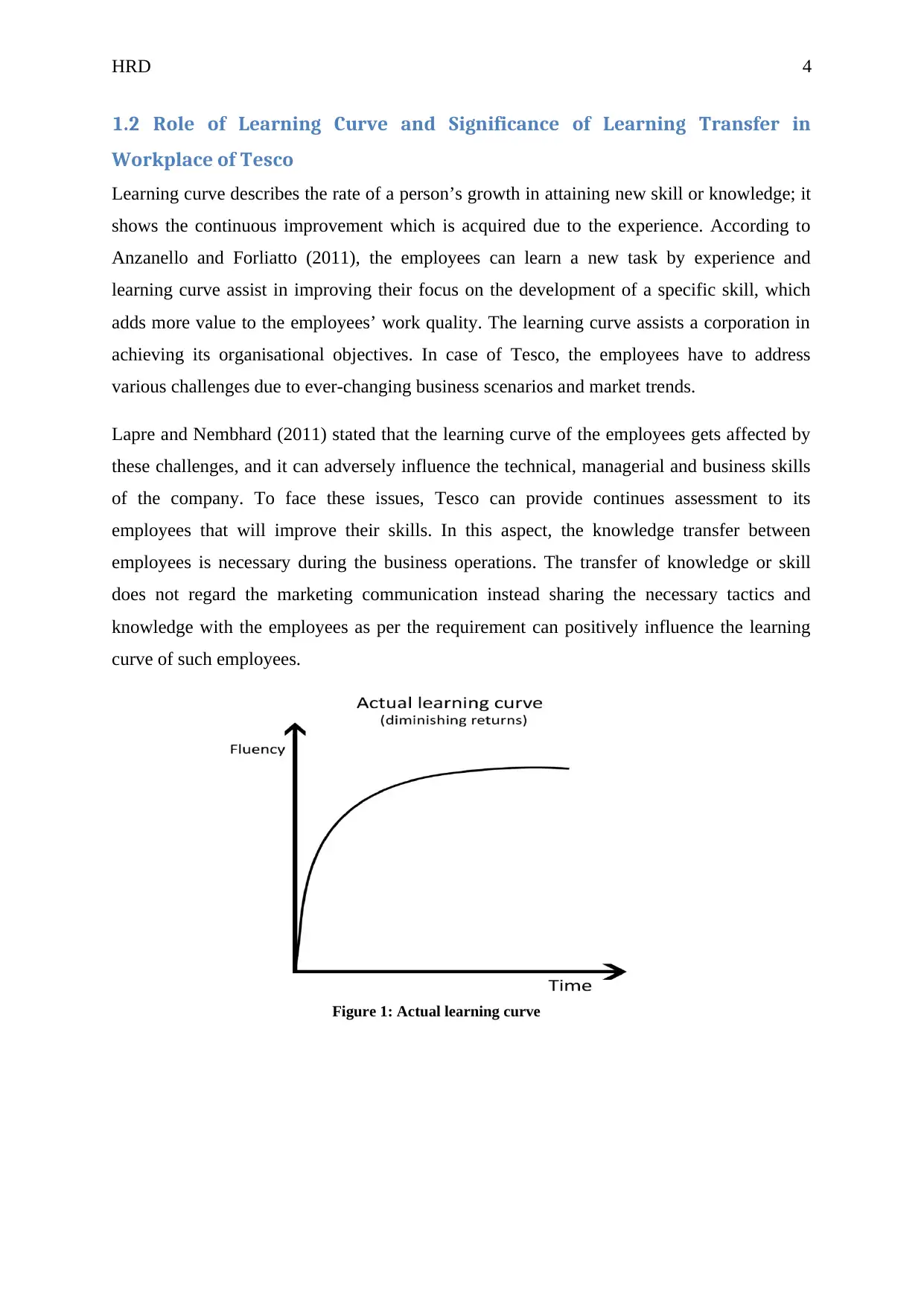
HRD 4
1.2 Role of Learning Curve and Significance of Learning Transfer in
Workplace of Tesco
Learning curve describes the rate of a person’s growth in attaining new skill or knowledge; it
shows the continuous improvement which is acquired due to the experience. According to
Anzanello and Forliatto (2011), the employees can learn a new task by experience and
learning curve assist in improving their focus on the development of a specific skill, which
adds more value to the employees’ work quality. The learning curve assists a corporation in
achieving its organisational objectives. In case of Tesco, the employees have to address
various challenges due to ever-changing business scenarios and market trends.
Lapre and Nembhard (2011) stated that the learning curve of the employees gets affected by
these challenges, and it can adversely influence the technical, managerial and business skills
of the company. To face these issues, Tesco can provide continues assessment to its
employees that will improve their skills. In this aspect, the knowledge transfer between
employees is necessary during the business operations. The transfer of knowledge or skill
does not regard the marketing communication instead sharing the necessary tactics and
knowledge with the employees as per the requirement can positively influence the learning
curve of such employees.
Figure 1: Actual learning curve
1.2 Role of Learning Curve and Significance of Learning Transfer in
Workplace of Tesco
Learning curve describes the rate of a person’s growth in attaining new skill or knowledge; it
shows the continuous improvement which is acquired due to the experience. According to
Anzanello and Forliatto (2011), the employees can learn a new task by experience and
learning curve assist in improving their focus on the development of a specific skill, which
adds more value to the employees’ work quality. The learning curve assists a corporation in
achieving its organisational objectives. In case of Tesco, the employees have to address
various challenges due to ever-changing business scenarios and market trends.
Lapre and Nembhard (2011) stated that the learning curve of the employees gets affected by
these challenges, and it can adversely influence the technical, managerial and business skills
of the company. To face these issues, Tesco can provide continues assessment to its
employees that will improve their skills. In this aspect, the knowledge transfer between
employees is necessary during the business operations. The transfer of knowledge or skill
does not regard the marketing communication instead sharing the necessary tactics and
knowledge with the employees as per the requirement can positively influence the learning
curve of such employees.
Figure 1: Actual learning curve
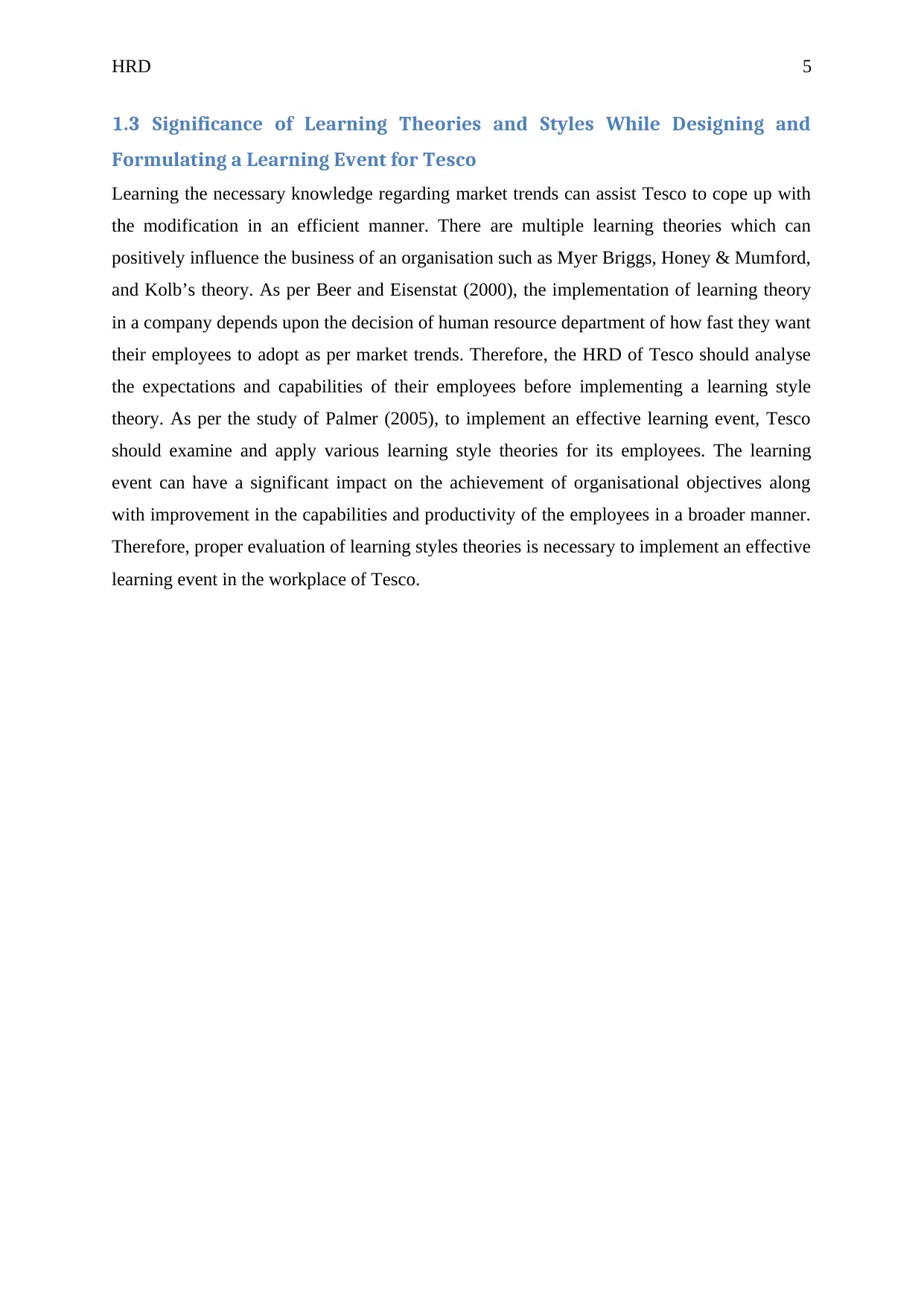
HRD 5
1.3 Significance of Learning Theories and Styles While Designing and
Formulating a Learning Event for Tesco
Learning the necessary knowledge regarding market trends can assist Tesco to cope up with
the modification in an efficient manner. There are multiple learning theories which can
positively influence the business of an organisation such as Myer Briggs, Honey & Mumford,
and Kolb’s theory. As per Beer and Eisenstat (2000), the implementation of learning theory
in a company depends upon the decision of human resource department of how fast they want
their employees to adopt as per market trends. Therefore, the HRD of Tesco should analyse
the expectations and capabilities of their employees before implementing a learning style
theory. As per the study of Palmer (2005), to implement an effective learning event, Tesco
should examine and apply various learning style theories for its employees. The learning
event can have a significant impact on the achievement of organisational objectives along
with improvement in the capabilities and productivity of the employees in a broader manner.
Therefore, proper evaluation of learning styles theories is necessary to implement an effective
learning event in the workplace of Tesco.
1.3 Significance of Learning Theories and Styles While Designing and
Formulating a Learning Event for Tesco
Learning the necessary knowledge regarding market trends can assist Tesco to cope up with
the modification in an efficient manner. There are multiple learning theories which can
positively influence the business of an organisation such as Myer Briggs, Honey & Mumford,
and Kolb’s theory. As per Beer and Eisenstat (2000), the implementation of learning theory
in a company depends upon the decision of human resource department of how fast they want
their employees to adopt as per market trends. Therefore, the HRD of Tesco should analyse
the expectations and capabilities of their employees before implementing a learning style
theory. As per the study of Palmer (2005), to implement an effective learning event, Tesco
should examine and apply various learning style theories for its employees. The learning
event can have a significant impact on the achievement of organisational objectives along
with improvement in the capabilities and productivity of the employees in a broader manner.
Therefore, proper evaluation of learning styles theories is necessary to implement an effective
learning event in the workplace of Tesco.
⊘ This is a preview!⊘
Do you want full access?
Subscribe today to unlock all pages.

Trusted by 1+ million students worldwide
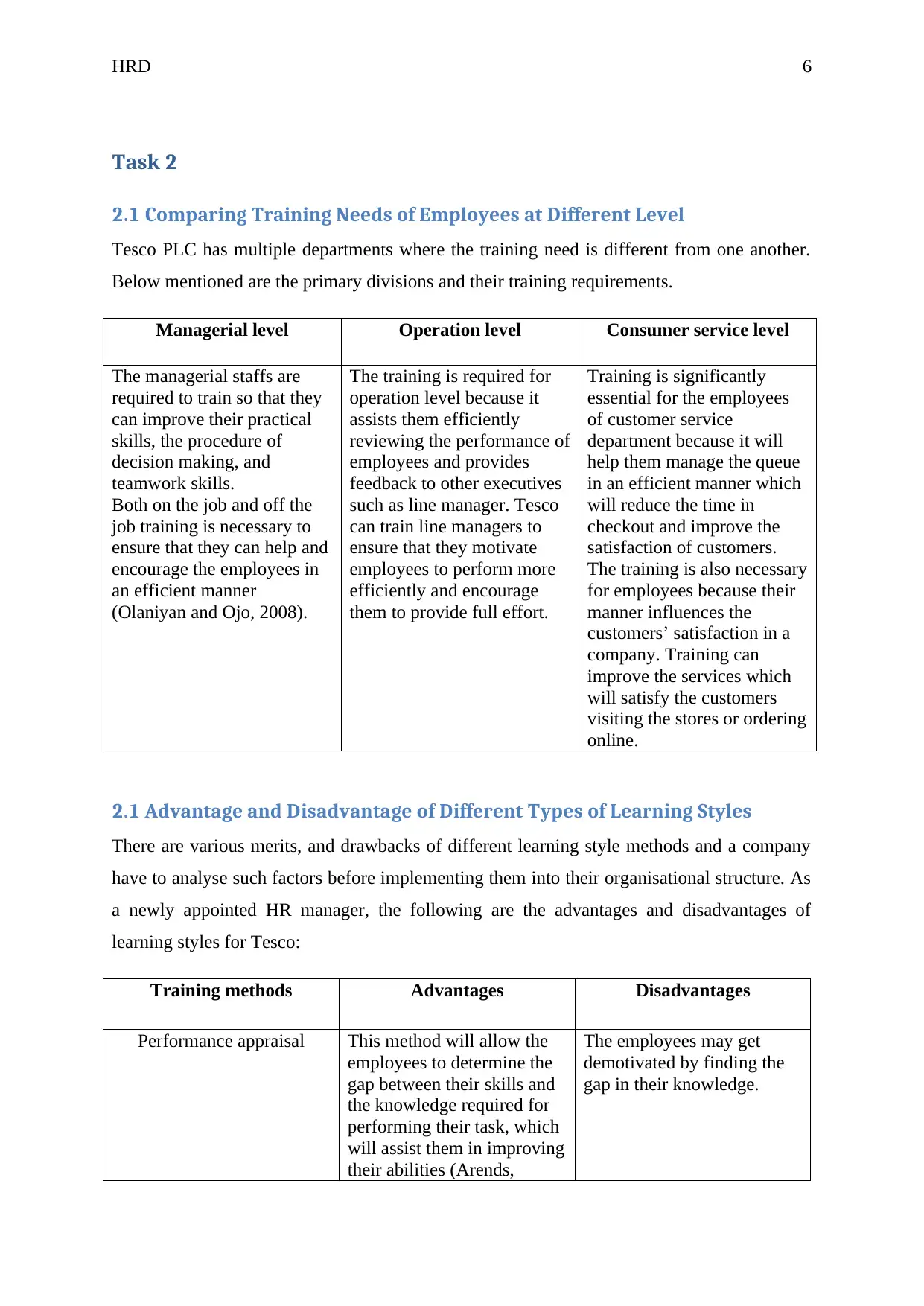
HRD 6
Task 2
2.1 Comparing Training Needs of Employees at Different Level
Tesco PLC has multiple departments where the training need is different from one another.
Below mentioned are the primary divisions and their training requirements.
Managerial level Operation level Consumer service level
The managerial staffs are
required to train so that they
can improve their practical
skills, the procedure of
decision making, and
teamwork skills.
Both on the job and off the
job training is necessary to
ensure that they can help and
encourage the employees in
an efficient manner
(Olaniyan and Ojo, 2008).
The training is required for
operation level because it
assists them efficiently
reviewing the performance of
employees and provides
feedback to other executives
such as line manager. Tesco
can train line managers to
ensure that they motivate
employees to perform more
efficiently and encourage
them to provide full effort.
Training is significantly
essential for the employees
of customer service
department because it will
help them manage the queue
in an efficient manner which
will reduce the time in
checkout and improve the
satisfaction of customers.
The training is also necessary
for employees because their
manner influences the
customers’ satisfaction in a
company. Training can
improve the services which
will satisfy the customers
visiting the stores or ordering
online.
2.1 Advantage and Disadvantage of Different Types of Learning Styles
There are various merits, and drawbacks of different learning style methods and a company
have to analyse such factors before implementing them into their organisational structure. As
a newly appointed HR manager, the following are the advantages and disadvantages of
learning styles for Tesco:
Training methods Advantages Disadvantages
Performance appraisal This method will allow the
employees to determine the
gap between their skills and
the knowledge required for
performing their task, which
will assist them in improving
their abilities (Arends,
The employees may get
demotivated by finding the
gap in their knowledge.
Task 2
2.1 Comparing Training Needs of Employees at Different Level
Tesco PLC has multiple departments where the training need is different from one another.
Below mentioned are the primary divisions and their training requirements.
Managerial level Operation level Consumer service level
The managerial staffs are
required to train so that they
can improve their practical
skills, the procedure of
decision making, and
teamwork skills.
Both on the job and off the
job training is necessary to
ensure that they can help and
encourage the employees in
an efficient manner
(Olaniyan and Ojo, 2008).
The training is required for
operation level because it
assists them efficiently
reviewing the performance of
employees and provides
feedback to other executives
such as line manager. Tesco
can train line managers to
ensure that they motivate
employees to perform more
efficiently and encourage
them to provide full effort.
Training is significantly
essential for the employees
of customer service
department because it will
help them manage the queue
in an efficient manner which
will reduce the time in
checkout and improve the
satisfaction of customers.
The training is also necessary
for employees because their
manner influences the
customers’ satisfaction in a
company. Training can
improve the services which
will satisfy the customers
visiting the stores or ordering
online.
2.1 Advantage and Disadvantage of Different Types of Learning Styles
There are various merits, and drawbacks of different learning style methods and a company
have to analyse such factors before implementing them into their organisational structure. As
a newly appointed HR manager, the following are the advantages and disadvantages of
learning styles for Tesco:
Training methods Advantages Disadvantages
Performance appraisal This method will allow the
employees to determine the
gap between their skills and
the knowledge required for
performing their task, which
will assist them in improving
their abilities (Arends,
The employees may get
demotivated by finding the
gap in their knowledge.
Paraphrase This Document
Need a fresh take? Get an instant paraphrase of this document with our AI Paraphraser
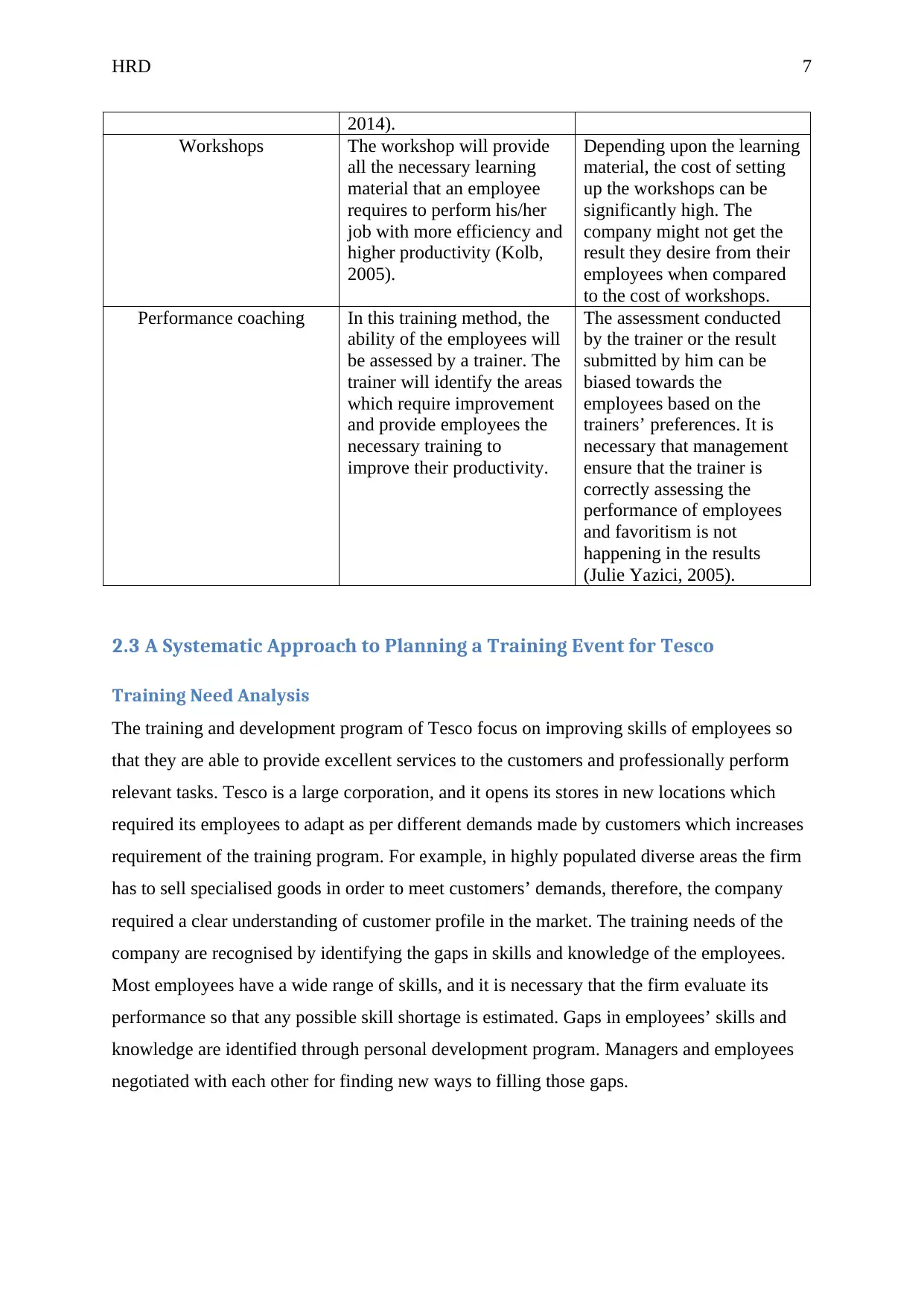
HRD 7
2014).
Workshops The workshop will provide
all the necessary learning
material that an employee
requires to perform his/her
job with more efficiency and
higher productivity (Kolb,
2005).
Depending upon the learning
material, the cost of setting
up the workshops can be
significantly high. The
company might not get the
result they desire from their
employees when compared
to the cost of workshops.
Performance coaching In this training method, the
ability of the employees will
be assessed by a trainer. The
trainer will identify the areas
which require improvement
and provide employees the
necessary training to
improve their productivity.
The assessment conducted
by the trainer or the result
submitted by him can be
biased towards the
employees based on the
trainers’ preferences. It is
necessary that management
ensure that the trainer is
correctly assessing the
performance of employees
and favoritism is not
happening in the results
(Julie Yazici, 2005).
2.3 A Systematic Approach to Planning a Training Event for Tesco
Training Need Analysis
The training and development program of Tesco focus on improving skills of employees so
that they are able to provide excellent services to the customers and professionally perform
relevant tasks. Tesco is a large corporation, and it opens its stores in new locations which
required its employees to adapt as per different demands made by customers which increases
requirement of the training program. For example, in highly populated diverse areas the firm
has to sell specialised goods in order to meet customers’ demands, therefore, the company
required a clear understanding of customer profile in the market. The training needs of the
company are recognised by identifying the gaps in skills and knowledge of the employees.
Most employees have a wide range of skills, and it is necessary that the firm evaluate its
performance so that any possible skill shortage is estimated. Gaps in employees’ skills and
knowledge are identified through personal development program. Managers and employees
negotiated with each other for finding new ways to filling those gaps.
2014).
Workshops The workshop will provide
all the necessary learning
material that an employee
requires to perform his/her
job with more efficiency and
higher productivity (Kolb,
2005).
Depending upon the learning
material, the cost of setting
up the workshops can be
significantly high. The
company might not get the
result they desire from their
employees when compared
to the cost of workshops.
Performance coaching In this training method, the
ability of the employees will
be assessed by a trainer. The
trainer will identify the areas
which require improvement
and provide employees the
necessary training to
improve their productivity.
The assessment conducted
by the trainer or the result
submitted by him can be
biased towards the
employees based on the
trainers’ preferences. It is
necessary that management
ensure that the trainer is
correctly assessing the
performance of employees
and favoritism is not
happening in the results
(Julie Yazici, 2005).
2.3 A Systematic Approach to Planning a Training Event for Tesco
Training Need Analysis
The training and development program of Tesco focus on improving skills of employees so
that they are able to provide excellent services to the customers and professionally perform
relevant tasks. Tesco is a large corporation, and it opens its stores in new locations which
required its employees to adapt as per different demands made by customers which increases
requirement of the training program. For example, in highly populated diverse areas the firm
has to sell specialised goods in order to meet customers’ demands, therefore, the company
required a clear understanding of customer profile in the market. The training needs of the
company are recognised by identifying the gaps in skills and knowledge of the employees.
Most employees have a wide range of skills, and it is necessary that the firm evaluate its
performance so that any possible skill shortage is estimated. Gaps in employees’ skills and
knowledge are identified through personal development program. Managers and employees
negotiated with each other for finding new ways to filling those gaps.
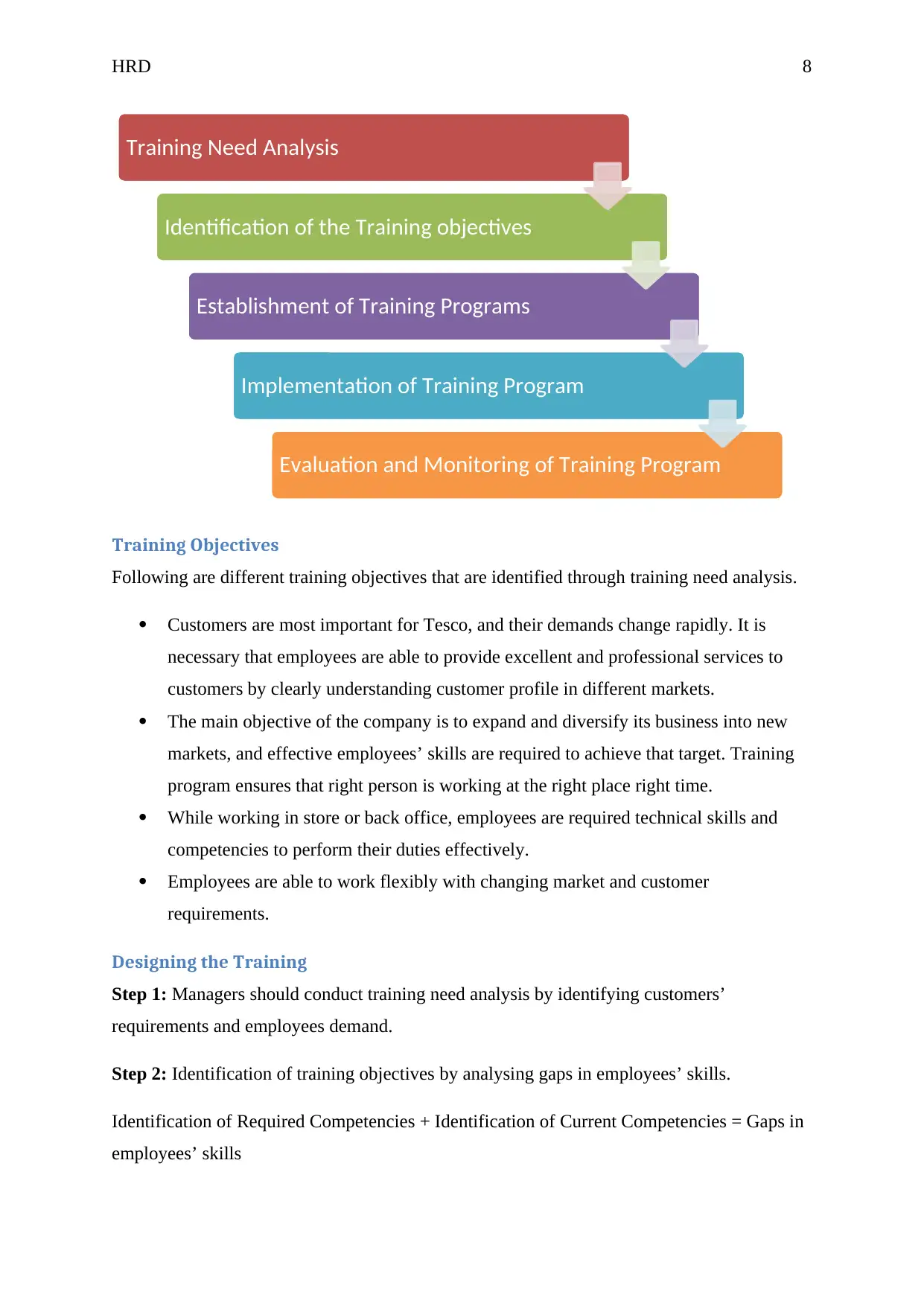
HRD 8
Training Objectives
Following are different training objectives that are identified through training need analysis.
Customers are most important for Tesco, and their demands change rapidly. It is
necessary that employees are able to provide excellent and professional services to
customers by clearly understanding customer profile in different markets.
The main objective of the company is to expand and diversify its business into new
markets, and effective employees’ skills are required to achieve that target. Training
program ensures that right person is working at the right place right time.
While working in store or back office, employees are required technical skills and
competencies to perform their duties effectively.
Employees are able to work flexibly with changing market and customer
requirements.
Designing the Training
Step 1: Managers should conduct training need analysis by identifying customers’
requirements and employees demand.
Step 2: Identification of training objectives by analysing gaps in employees’ skills.
Identification of Required Competencies + Identification of Current Competencies = Gaps in
employees’ skills
Training Need Analysis
Identification of the Training objectives
Establishment of Training Programs
Implementation of Training Program
Evaluation and Monitoring of Training Program
Training Objectives
Following are different training objectives that are identified through training need analysis.
Customers are most important for Tesco, and their demands change rapidly. It is
necessary that employees are able to provide excellent and professional services to
customers by clearly understanding customer profile in different markets.
The main objective of the company is to expand and diversify its business into new
markets, and effective employees’ skills are required to achieve that target. Training
program ensures that right person is working at the right place right time.
While working in store or back office, employees are required technical skills and
competencies to perform their duties effectively.
Employees are able to work flexibly with changing market and customer
requirements.
Designing the Training
Step 1: Managers should conduct training need analysis by identifying customers’
requirements and employees demand.
Step 2: Identification of training objectives by analysing gaps in employees’ skills.
Identification of Required Competencies + Identification of Current Competencies = Gaps in
employees’ skills
Training Need Analysis
Identification of the Training objectives
Establishment of Training Programs
Implementation of Training Program
Evaluation and Monitoring of Training Program
⊘ This is a preview!⊘
Do you want full access?
Subscribe today to unlock all pages.

Trusted by 1+ million students worldwide
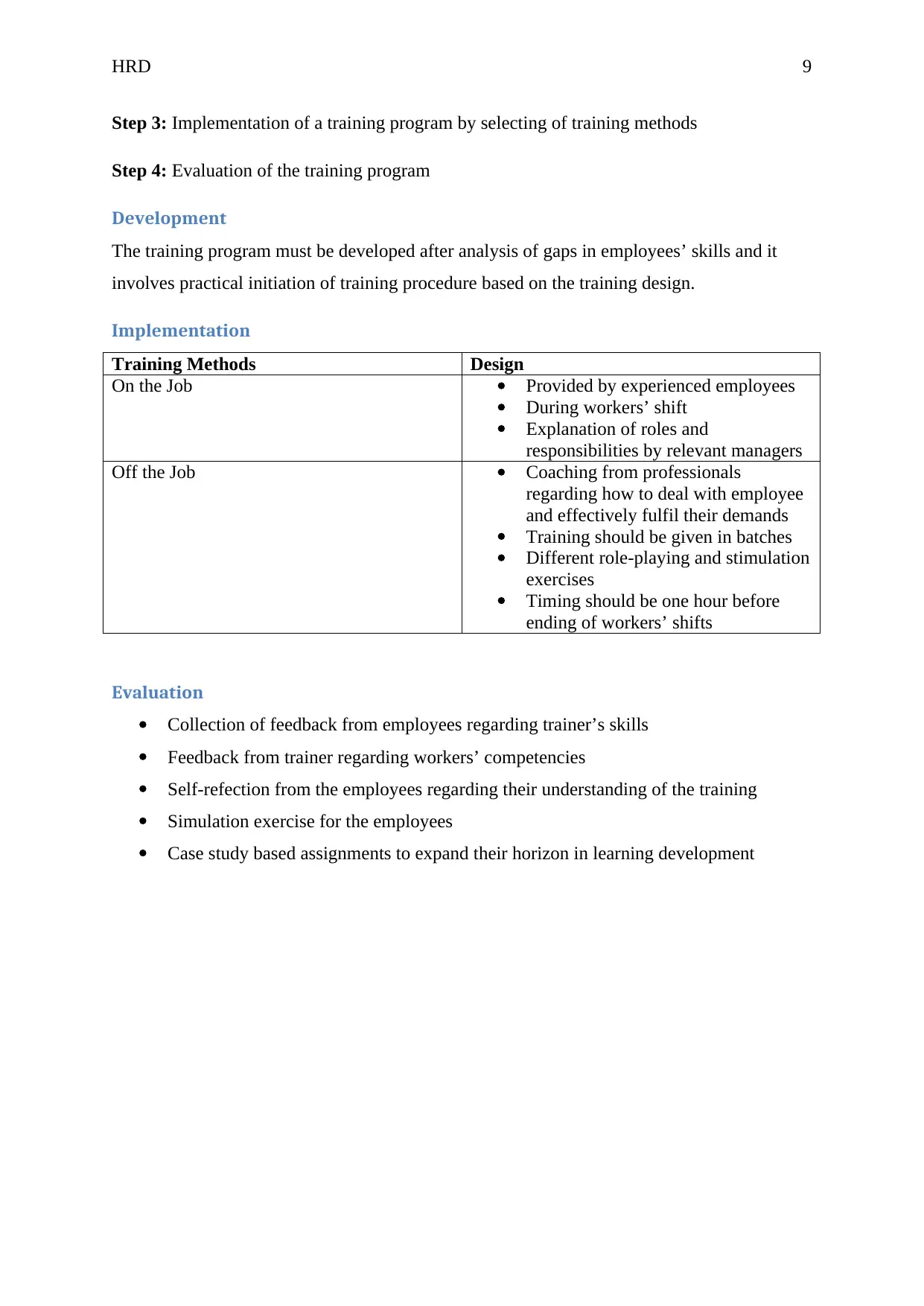
HRD 9
Step 3: Implementation of a training program by selecting of training methods
Step 4: Evaluation of the training program
Development
The training program must be developed after analysis of gaps in employees’ skills and it
involves practical initiation of training procedure based on the training design.
Implementation
Training Methods Design
On the Job Provided by experienced employees
During workers’ shift
Explanation of roles and
responsibilities by relevant managers
Off the Job Coaching from professionals
regarding how to deal with employee
and effectively fulfil their demands
Training should be given in batches
Different role-playing and stimulation
exercises
Timing should be one hour before
ending of workers’ shifts
Evaluation
Collection of feedback from employees regarding trainer’s skills
Feedback from trainer regarding workers’ competencies
Self-refection from the employees regarding their understanding of the training
Simulation exercise for the employees
Case study based assignments to expand their horizon in learning development
Step 3: Implementation of a training program by selecting of training methods
Step 4: Evaluation of the training program
Development
The training program must be developed after analysis of gaps in employees’ skills and it
involves practical initiation of training procedure based on the training design.
Implementation
Training Methods Design
On the Job Provided by experienced employees
During workers’ shift
Explanation of roles and
responsibilities by relevant managers
Off the Job Coaching from professionals
regarding how to deal with employee
and effectively fulfil their demands
Training should be given in batches
Different role-playing and stimulation
exercises
Timing should be one hour before
ending of workers’ shifts
Evaluation
Collection of feedback from employees regarding trainer’s skills
Feedback from trainer regarding workers’ competencies
Self-refection from the employees regarding their understanding of the training
Simulation exercise for the employees
Case study based assignments to expand their horizon in learning development
Paraphrase This Document
Need a fresh take? Get an instant paraphrase of this document with our AI Paraphraser
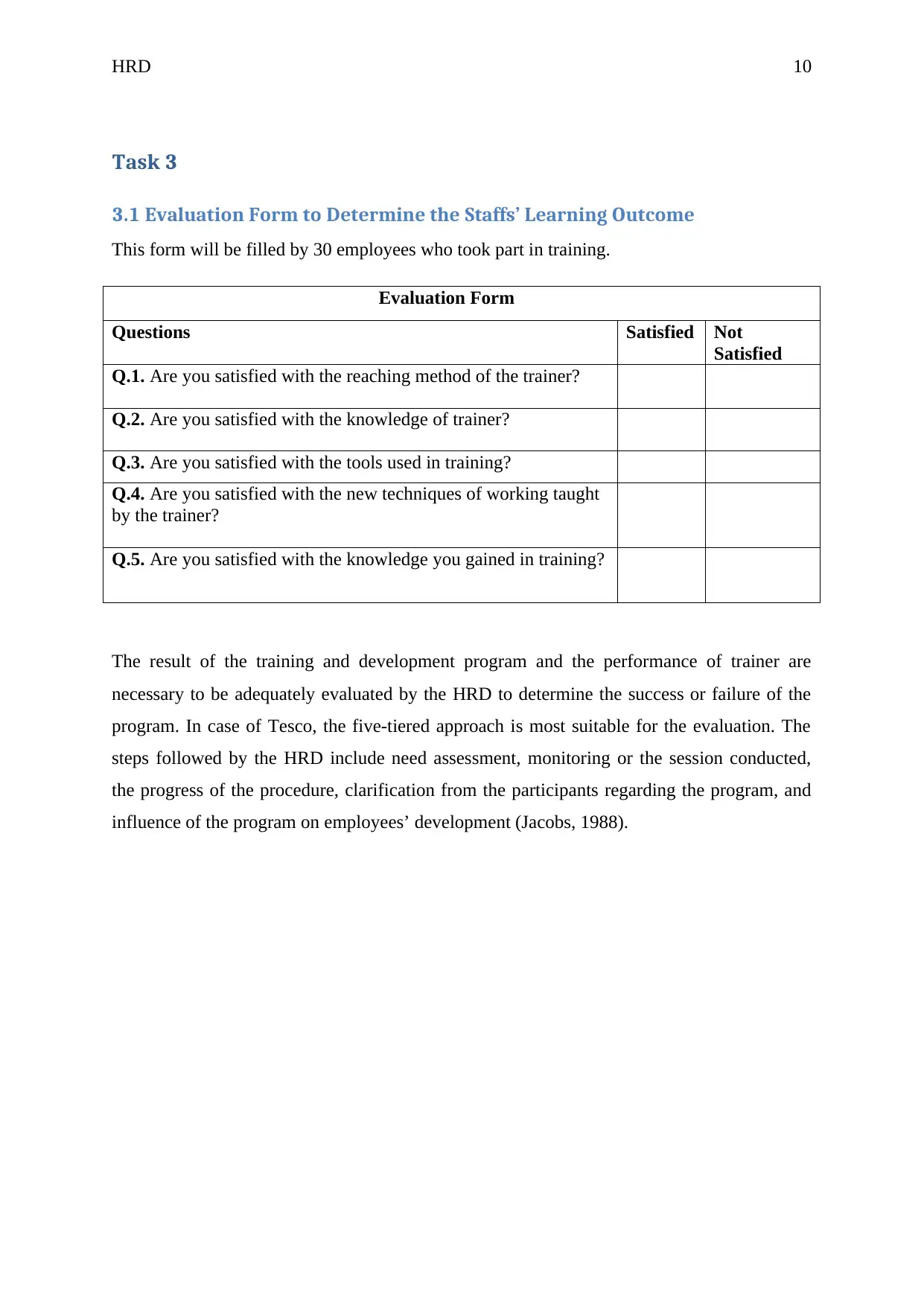
HRD 10
Task 3
3.1 Evaluation Form to Determine the Staffs’ Learning Outcome
This form will be filled by 30 employees who took part in training.
Evaluation Form
Questions Satisfied Not
Satisfied
Q.1. Are you satisfied with the reaching method of the trainer?
Q.2. Are you satisfied with the knowledge of trainer?
Q.3. Are you satisfied with the tools used in training?
Q.4. Are you satisfied with the new techniques of working taught
by the trainer?
Q.5. Are you satisfied with the knowledge you gained in training?
The result of the training and development program and the performance of trainer are
necessary to be adequately evaluated by the HRD to determine the success or failure of the
program. In case of Tesco, the five-tiered approach is most suitable for the evaluation. The
steps followed by the HRD include need assessment, monitoring or the session conducted,
the progress of the procedure, clarification from the participants regarding the program, and
influence of the program on employees’ development (Jacobs, 1988).
Task 3
3.1 Evaluation Form to Determine the Staffs’ Learning Outcome
This form will be filled by 30 employees who took part in training.
Evaluation Form
Questions Satisfied Not
Satisfied
Q.1. Are you satisfied with the reaching method of the trainer?
Q.2. Are you satisfied with the knowledge of trainer?
Q.3. Are you satisfied with the tools used in training?
Q.4. Are you satisfied with the new techniques of working taught
by the trainer?
Q.5. Are you satisfied with the knowledge you gained in training?
The result of the training and development program and the performance of trainer are
necessary to be adequately evaluated by the HRD to determine the success or failure of the
program. In case of Tesco, the five-tiered approach is most suitable for the evaluation. The
steps followed by the HRD include need assessment, monitoring or the session conducted,
the progress of the procedure, clarification from the participants regarding the program, and
influence of the program on employees’ development (Jacobs, 1988).
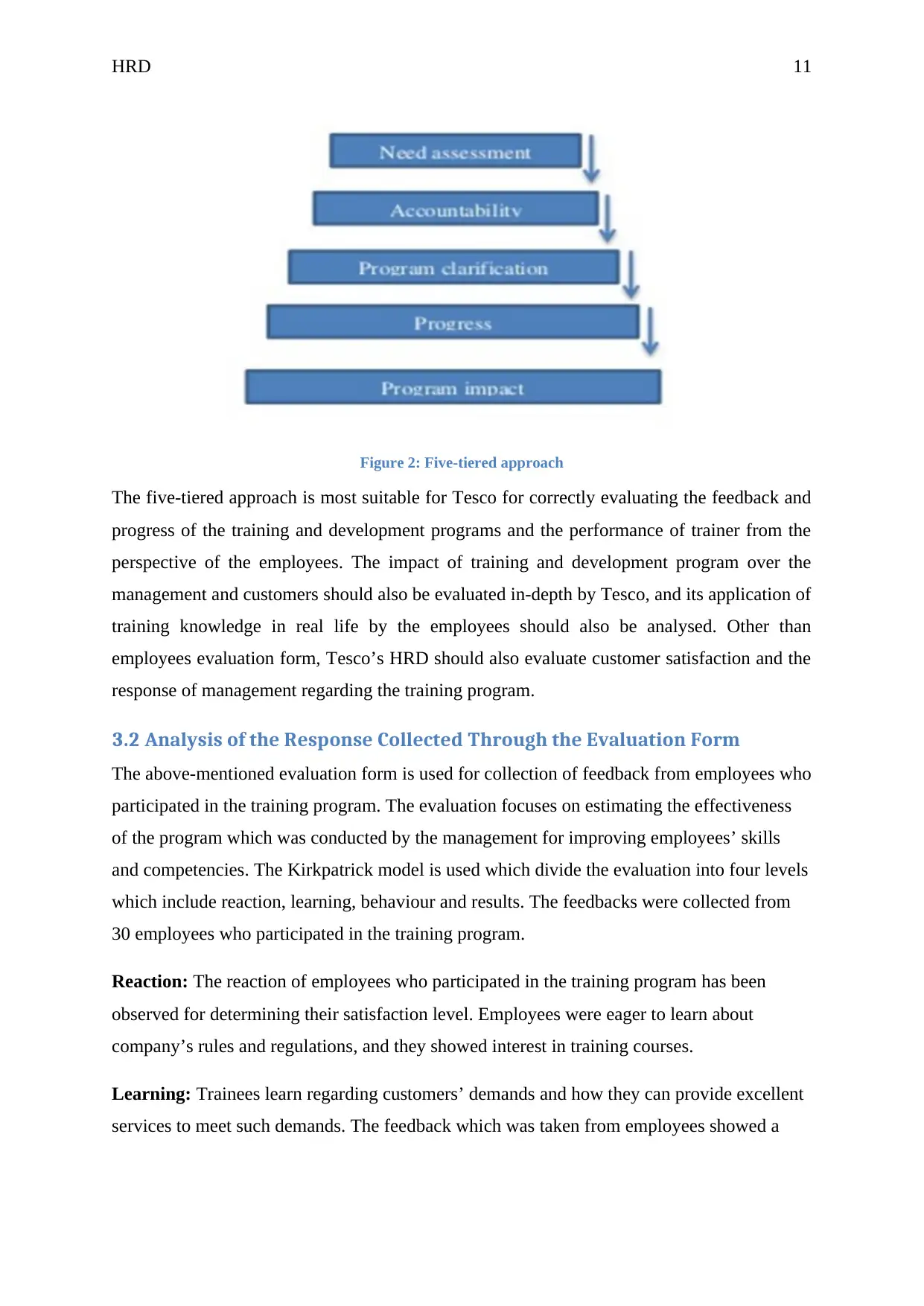
HRD 11
Figure 2: Five-tiered approach
The five-tiered approach is most suitable for Tesco for correctly evaluating the feedback and
progress of the training and development programs and the performance of trainer from the
perspective of the employees. The impact of training and development program over the
management and customers should also be evaluated in-depth by Tesco, and its application of
training knowledge in real life by the employees should also be analysed. Other than
employees evaluation form, Tesco’s HRD should also evaluate customer satisfaction and the
response of management regarding the training program.
3.2 Analysis of the Response Collected Through the Evaluation Form
The above-mentioned evaluation form is used for collection of feedback from employees who
participated in the training program. The evaluation focuses on estimating the effectiveness
of the program which was conducted by the management for improving employees’ skills
and competencies. The Kirkpatrick model is used which divide the evaluation into four levels
which include reaction, learning, behaviour and results. The feedbacks were collected from
30 employees who participated in the training program.
Reaction: The reaction of employees who participated in the training program has been
observed for determining their satisfaction level. Employees were eager to learn about
company’s rules and regulations, and they showed interest in training courses.
Learning: Trainees learn regarding customers’ demands and how they can provide excellent
services to meet such demands. The feedback which was taken from employees showed a
Figure 2: Five-tiered approach
The five-tiered approach is most suitable for Tesco for correctly evaluating the feedback and
progress of the training and development programs and the performance of trainer from the
perspective of the employees. The impact of training and development program over the
management and customers should also be evaluated in-depth by Tesco, and its application of
training knowledge in real life by the employees should also be analysed. Other than
employees evaluation form, Tesco’s HRD should also evaluate customer satisfaction and the
response of management regarding the training program.
3.2 Analysis of the Response Collected Through the Evaluation Form
The above-mentioned evaluation form is used for collection of feedback from employees who
participated in the training program. The evaluation focuses on estimating the effectiveness
of the program which was conducted by the management for improving employees’ skills
and competencies. The Kirkpatrick model is used which divide the evaluation into four levels
which include reaction, learning, behaviour and results. The feedbacks were collected from
30 employees who participated in the training program.
Reaction: The reaction of employees who participated in the training program has been
observed for determining their satisfaction level. Employees were eager to learn about
company’s rules and regulations, and they showed interest in training courses.
Learning: Trainees learn regarding customers’ demands and how they can provide excellent
services to meet such demands. The feedback which was taken from employees showed a
⊘ This is a preview!⊘
Do you want full access?
Subscribe today to unlock all pages.

Trusted by 1+ million students worldwide
1 out of 20
Related Documents
Your All-in-One AI-Powered Toolkit for Academic Success.
+13062052269
info@desklib.com
Available 24*7 on WhatsApp / Email
![[object Object]](/_next/static/media/star-bottom.7253800d.svg)
Unlock your academic potential
Copyright © 2020–2025 A2Z Services. All Rights Reserved. Developed and managed by ZUCOL.





